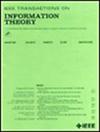Higher-Order Staircase Codes
IF 2.2
3区 计算机科学
Q3 COMPUTER SCIENCE, INFORMATION SYSTEMS
引用次数: 0
Abstract
We generalize staircase codes and tiled diagonal zipper codes, preserving their key properties while allowing each coded symbol to be protected by arbitrarily many component codewords rather than only two. This generalization which we term “higher-order staircase codes” arises from the marriage of two distinct combinatorial objects: difference triangle sets and finite-geometric nets, which have typically been applied separately to code design. We demonstrate one possible realization of these codes, obtaining powerful, high-rate, low-error-floor, and low-complexity coding schemes based on simple iterative syndrome-domain decoding of coupled Hamming component codes. We anticipate that the proposed codes could improve performance–complexity–latency tradeoffs in high-throughput communications applications, most notably fiber-optic, in which classical staircase codes and zipper codes have been applied. We consider the construction of difference triangle sets having minimum scope and sum-of-lengths, which lead to memory-optimal realizations of higher-order staircase codes. These results also enable memory reductions for early families of convolutional codes constructed from difference triangle sets.高阶阶梯码
我们推广了楼梯码和平铺对角线拉链码,保留了它们的关键属性,同时允许每个编码符号由任意多个组件码字而不是只有两个来保护。我们称之为“高阶阶梯代码”的这种概括源于两个不同组合对象的结合:差分三角形集和有限几何网,它们通常分别应用于代码设计。我们展示了这些码的一种可能实现,基于耦合汉明分量码的简单迭代综合征域解码,获得了强大、高速率、低错误层和低复杂度的编码方案。我们预计,所提出的代码可以改善高吞吐量通信应用中的性能复杂性和延迟权衡,特别是光纤,其中经典的楼梯代码和拉链代码已经应用。我们考虑了具有最小范围和长度和的差分三角形集的构造,从而实现了高阶阶梯码的记忆优化。这些结果还可以减少由差三角集构造的早期卷积码族的内存。
本文章由计算机程序翻译,如有差异,请以英文原文为准。
求助全文
约1分钟内获得全文
求助全文
来源期刊

IEEE Transactions on Information Theory
工程技术-工程:电子与电气
CiteScore
5.70
自引率
20.00%
发文量
514
审稿时长
12 months
期刊介绍:
The IEEE Transactions on Information Theory is a journal that publishes theoretical and experimental papers concerned with the transmission, processing, and utilization of information. The boundaries of acceptable subject matter are intentionally not sharply delimited. Rather, it is hoped that as the focus of research activity changes, a flexible policy will permit this Transactions to follow suit. Current appropriate topics are best reflected by recent Tables of Contents; they are summarized in the titles of editorial areas that appear on the inside front cover.
 求助内容:
求助内容: 应助结果提醒方式:
应助结果提醒方式:


